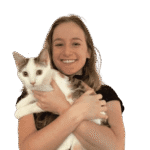Starting solids is an important milestone for you and your baby!
It’s an exciting new stage in your baby’s development that often comes with a lot of questions:
- When should I start?
- What should I feed my baby?
- How often should I feed them solids?
- What about allergens & choking hazards?
- Can I prevent picky eating?
- Below is information to help you get started and hopefully feel more confident.
When Should I Start?
Right around 6 months of age (but consult your pediatrician as there can sometimes be a
reason to start a little bit earlier or a little bit later).
When your baby shows these signs of readiness:
- Sits upright with minimal support
- Good head & neck control
- Reaches for objects & brings them to their mouth
- Shows an interest in food such as: looking at food on your plate, watching intently as you eat, reaching out for food, opens mouth for a spoon
What Should I Feed My Baby?
You can follow a traditional approach starting with spoon-feeding purees and increasing texture over time or you may choose a baby-led weaning approach, offering your baby finger foods from the start and skipping the spoon-feeding together. Either approach can work and neither is “best!” It depends on your preferences and your baby. Oftentimes, a combination is
ideal. You can offer your baby finger foods from the beginning as well as purees.
It’s important to consider yourself and your baby when deciding on an approach. Are you really
anxious about starting solids? Are you worried you won’t have enough time in the day for baby-led weaning? Has your baby been delayed in meeting gross motor milestones or are there other developmental concerns? If so, starting with purees for a short time may be helpful.
If you choose to spoon-feed purees, try offering your baby their own spoon too. You can
encourage them to try bringing the spoon to their mouth and help them by pre-loading the
spoon with food. This gives your baby a sense of control and experience with self-feeding even
if you are following a more traditional approach with purees.
You can also offer your baby harder-to-chew foods inside a silicone or mesh feeder. This allows them to practice self-feeding
by bringing the feeder to their mouth for munching but provides peace of mind for you since
they won’t be able to get a big piece out.
Whichever approach you choose, it is important for your baby to have experience self-feeding
and exposure to more textured foods (thick purees, lumpy mashed foods, or finger foods) by 9
months of age. A research study by Coulthard, Harris, & Emmett (2009) found that babies who
were not introduced to lumpy solids by 9 months of age actually ate fewer fruits and
vegetables at 7 years old. Exposure to a variety of foods and textures early on is very
important!
How Often Should I Give Them Solids?
Start with 1 solids meal per day, increasing to 2 meals around 8 months, and adding a 3rd
solids meal around 10 months. The volume they eat will be very small at first and that’s okay! It
may also vary from day to day. Try not to worry about how much they actually eat and
remember that this is a time for learning and building new skills. Trust that your baby knows
how much they need and that breastmilk or formula will continue to provide the majority of
nutrition they need until 12 months of age.
What About Allergens & Choking Hazards?
The American Academy of Pediatrics recommends the early introduction of potential allergens as
soon as your baby has started solids. Potentially allergenic foods include peanuts, eggs, fish,
shellfish, tree nuts, soy, sesame, wheat, & cow’s milk products. You should introduce one of
these foods at a time, offer it during the day so you can monitor for any reaction, and start with
small amounts. You can increase the amount gradually as you try the food multiple times. If
baby tolerates it well, keep it as a regular part of their diet. Continued exposure to these foods
is important.
If your baby is at high risk (has severe eczema, existing egg or milk protein allergy, or strong
family history), consult with your pediatrician before starting solids as the recommendations
may differ.
Some foods pose a greater risk of choking than others. These tend to be firm, round, small,
and difficult to chew. It is important to know which foods are most likely to cause choking and
know how to modify these to present to your baby. A great resource for this information is Solid
Starts: https://solidstarts.com/choking-hazards-babies/ To alleviate some anxiety about choking, consider taking an infant CPR & choking prevention class at Manhattan Valley Pediatrics.
Can I Prevent Picky Eating?
Almost every child will go through a stage of picky eating, usually between the ages of 2 and 4.
This is normal and expected! Between 18 months and 2 years of age, neophobia (fear of new
foods) peaks and toddlers begin to crave independence and control. Eating is one of the things
they can control! Although frustrating, nearly ever toddler parent has to deal with this stage.
Here are a few tips to help set your toddler up for good eating habits later in life
- Expose, expose, expose! Repeated exposure to new foods is extremely important. Even
when your picky eater doesn’t taste the food, they are getting used to seeing it on the table.
It can take up to 15-20 exposure for a child to try new food and even more tastes of a new
food to decide if they like it. - Enjoy family meals. Eat meals together as often as you can to model good eating habits and
enjoy time together around food. - Get your child involved in the kitchen. Have them help you in whatever way they can with
preparing food. They can help with measuring, washing, pouring, or stirring. You can also
have them help with grocery shopping or putting food away if you get groceries delivered.
Again, the more positive experience they have around food, the better! - Avoid pressure to eat. Bribing, begging, and negotiating are unlikely to work long-term.
Avoid these mealtime battles as much as you can by offering a balanced meal or snack that
includes at least one food your child normally eats. If they only eat that food and nothing else
you offered, that’s okay! Continue to offer.
When Might We Need Professional Help?
Below are some red flags that indicate your child might benefit from a consultation with an SLP
who specializes in feeding:
- Refuses to accept any solid food
- Cries and/or arches back at most meals
- Frequent coughing or choking with food or liquid
- Not progressing to lumpy/mashed textures or meltable solids by 9 months
- Not progressing to soft table foods by 12 months
- Often gagging to the point of vomiting with solid food
- Only eating when distracted by tv, music, etc.
- Won’t self feed with utensils or hands
- Lengthy feeding times (more than 30 minutes)
- Ongoing poor weight gain
- Toddler or school-age child who eats less than 20 different foods
For more information about the author and facilitator of the workshops, Starting Solids and Picky Eaters for MVP families, check out Jordan Bills and her practice, Nuture Speech and Feeding Therapy, located on the Upper West Side. Contact Jordan for more details on her location and availability.
References:
Coulthard, H., Harris, G., & Emmett, P. (2009). Delayed introduction of lumpy foods to children
during the complementary feeding period affects child’s food acceptance and feeding at 7
years of age. Maternal & child nutrition, 5(1), 75–85. https://doi.org/10.1111/
j.1740-8709.2008.00153.x
CDC. (2018, December 3).
When, What, and How to Introduce Solid Foods. Centers for Disease Control and Prevention. https://www.cdc.gov/nutrition/infantandtoddlernutrition/foods-
and-drinks/when-to-introduce-solid-foods.html
Du Plessis, L., Kruger, H., & Sweet, L. (2013). II. Complementary feeding: a critical window of
opportunity from six months onwards. South African Journal of Clinical Nutrition, 26(S), S129-
S140. Retrieved from http://sajcn.co.za/index.php/SAJCN/article/view/757
Infant Food and Feeding. (n.d.). www.aap.org. https://www.aap.org/en/patient-care/healthy-
active-living-for-families/infant-food-and-feeding/
Samady W, Campbell E, Aktas ON, et al. Recommendations on Complementary Food
Introduction Among Pediatric Practitioners. JAMA Netw Open. 2020;3(8):e2013070.
doi:10.1001/jamanetworkopen.2020.13070





